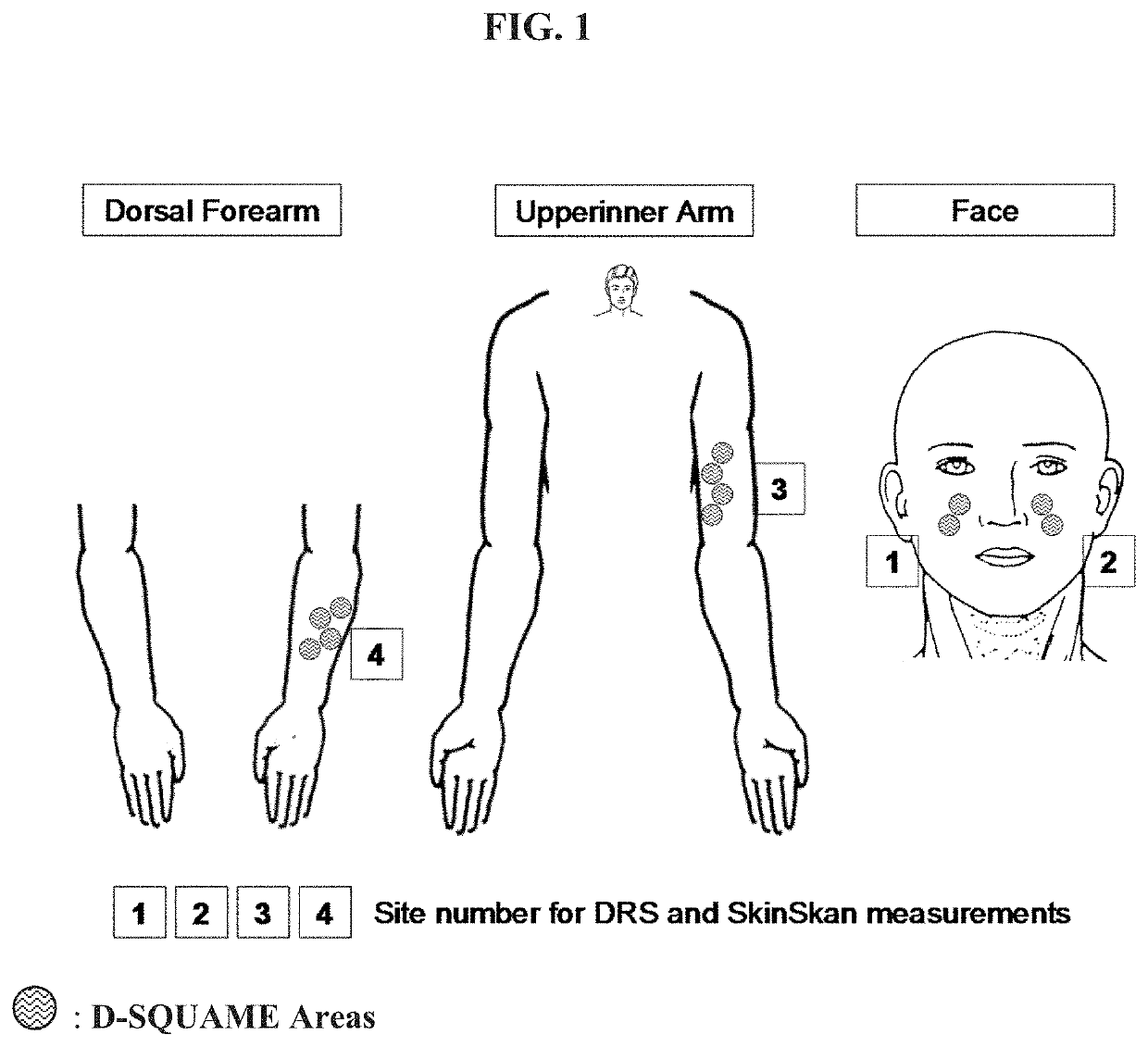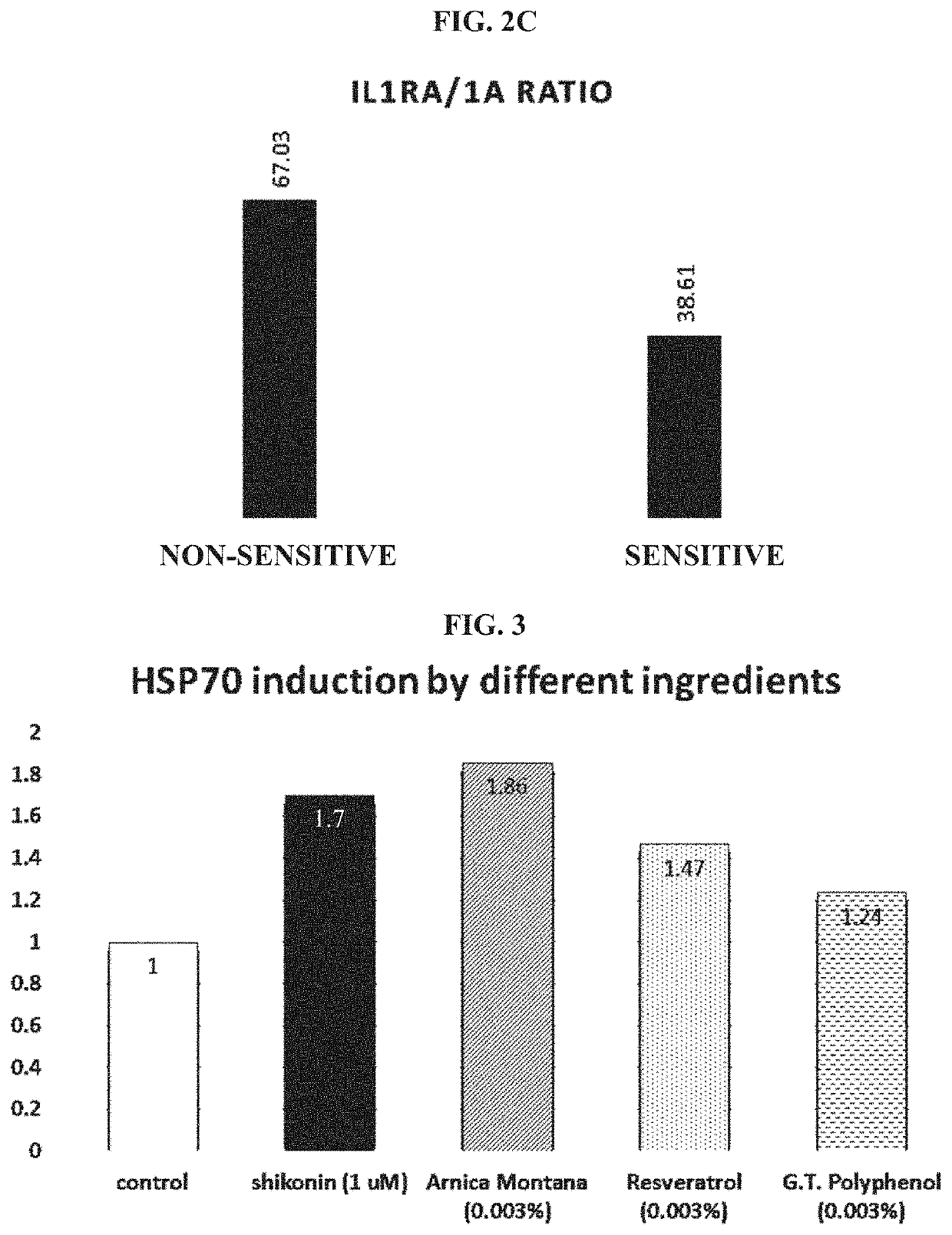Protein Biomarkers for Identifying and Treating Aging Skin and Skin Conditions
a technology of aging skin and biomarkers, applied in the field of protein biomarkers for identifying and treating aging skin and skin conditions, can solve the problems of reducing affecting the condition and appearance of the subject, and affecting the health of the subject, so as to reduce the risk of a subject developing more wrinkles or fine lines, and reduce the specific protein level of the skin
- Summary
- Abstract
- Description
- Claims
- Application Information
AI Technical Summary
Benefits of technology
Problems solved by technology
Method used
Image
Examples
example 1
Evaluation of Skin Aging Biomarkers in the Skin Stratum Corneum of Young Versus Old Human Subjects (Clinical Study)
Background and Rationale of Study
[0118]The aging of human skin manifests itself in many ways, particularly on the sun-exposed areas of the body. Exposure to decades of sunlight results in a gradual structural degradation and the appearance of an assortment of unwelcome signs of photoaging, viz. dyspigmentation, wrinkles, roughness, dullness, yellowness, leathery texture and laxity. These adverse changes appear more prominently on the dorsal forearms and the face, since these parts of the body are relatively more exposed to sun during everyday activities. In the middle to later years of life, the degradation of skin increases significantly.
[0119]Some of the symptoms of aging skin are the result of degradation of collagen and elastin fibers, thinning of skin and subcutaneous adipose tissue layers. This is accompanied by dry / scaly and rough skin. Biochemical changes and ch...
example 2
Assessment of Correlation Between Protein Biomarkers and Skin Attributes
[0153]For this analysis, 30 subjects aged 35-45 years were recruited for a protein biomarker validation study. Tape strips were applied and removed from the cheek areas of the subjects and analyzed for various protein biomarkers as described supra. Before taking the tape strips, the subjects were asked several questions regarding their skin. The questions asked were as follows: 1) Do you think you have sensitive skin?; 2) Do you think you have more or less wrinkles for your age?; 3) Do you consider your skin to be oily, dry, or normal?; and 4) Do you think your skin tone is normal for your age?. The photos of the faces of the subjects were also graded (with a scale from 0-10, with 10 as the most and 0 as the least) by a dermatologist for the following visible or tactile attributes: fine wrinkles, coarse wrinkles, mottled pigmentation, discreet pigmentation, erythema and blotchiness. The correlation between 1) pr...
example 3
[0155]ELISA Measurements with HSP70 Inducing Agents
[0156]Normal human dermal fibroblasts (Cascade Biologics) were seeded into four wells of a six well plate (5.0×105 cells / well) and cultured overnight. The following day, cells were replenished with fresh media and test compositions were added. The test compositions including their control for each formulation:
[0157]a) control 1 (50:50 EtOH:H2O);
[0158]b) 0.1% (w / w) Tiliacora triandra extract (extraction medium: ethanol:water in a volume ratio of 80:20);
[0159]c) 0.01% (w / w) ethanolic Tiliacora triandra extract;
[0160]d) control 2 (H2O)
[0161]e) 0.1% (w / w) aqueous Portulaca oleracera extract;
[0162]f) 0.01% (w / w) aqueous Portulaca oleracera extract;
[0163]g) control 3 (EtOH);
[0164]h) 0.001% cannabidiol (CBD; 99% ethanolic extract);
[0165]h) control 4 (dimethylsulfoxide (DMSO))
[0166]f) 0.01% (w / w) Phytol;
[0167]g) 0.001% (w / w) Phytol; and
[0168]h) 0.01% (w / w) Arnica montana extract (Positive Control).
The active ingredient was formulated in one...
PUM
 Login to View More
Login to View More Abstract
Description
Claims
Application Information
 Login to View More
Login to View More - R&D
- Intellectual Property
- Life Sciences
- Materials
- Tech Scout
- Unparalleled Data Quality
- Higher Quality Content
- 60% Fewer Hallucinations
Browse by: Latest US Patents, China's latest patents, Technical Efficacy Thesaurus, Application Domain, Technology Topic, Popular Technical Reports.
© 2025 PatSnap. All rights reserved.Legal|Privacy policy|Modern Slavery Act Transparency Statement|Sitemap|About US| Contact US: help@patsnap.com



